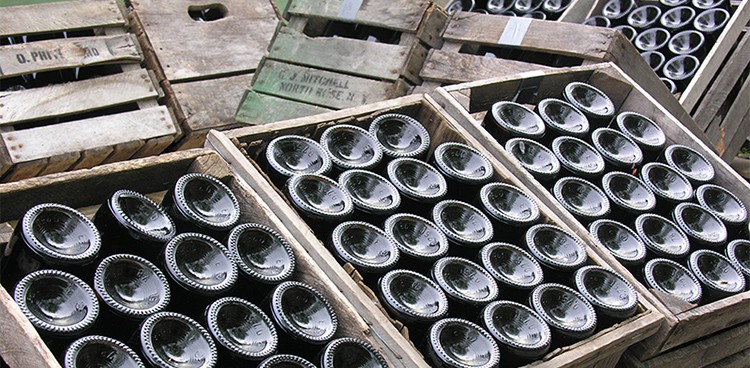
My Midwestern childhood brought with it some obligatory seasonal traditions: Sweet corn in the summer. Snow shoveling in the winter. Mud puddles come spring. And, of course, an annual visit to our local apple orchard in the fall—complete with apple picking, apple fritters, apple butter, and apple juice.
It didn’t occur to me back then that a little bit of commercial yeast, when added to that freshly pressed juice, could create a wonderful version of apple juice that makes you feel funny after a few glasses. The idea occurred to the English at some point around 55 B.C., when the Roman Empire arrived to find the locals sipping on some sort of apple-based libation.
The English and French cider-making traditions that grew from humble beginnings eventually made their way to the New World; prior to Prohibition, cider was a mainstay on farmhouse tables throughout the East Coast. But despite Johnny Appleseed’s storied seed sowing, the tea-toting prohibitionists behind “The Noble Experiment” made an indelible mark on the American cider story. The very definition of cider became a little fuzzy around this time—hence the use of “hard” cider when describing apple juice that’s gone through fermentation.
Today’s American apple growers and artisan cider makers are still making strides to reverse the effects of Prohibition—much like American craft beer brewers—creating fermented cider using methods that Europeans have employed for thousands of years. These traditions include growing apples with characteristics—higher sugar content, lots of tannins, unique flavors—better suited for cider making. You wouldn’t necessarily want to take a big bite out of one of these apples, but they’re ripe for the fermentation and aging needed to create a great cider.
Cultivating the right type of apples, however, is only the beginning. Once apples have been harvested, they are ground and smashed into a pulpy mess called pommace. The concoction is then placed between layers of cloth held together on wooden racks, which strain liquids from the apple solids and prevent the pommace from oxidizing. The racks of cloth are then pressed—typically with a hydraulic cylinder—until all of the juice has been collected.
That fresh juice is liquid gold for cider makers. It’s good fruit, after all, that makes good cider. From this raw stage the juice will be manipulated and coaxed into whatever the intended end product may be. Depending on production and aging techniques, and on the varieties of apples in use, an artisan cider may take on any number of styles and flavor characteristics: dry, bone-dry, off-dry, sweet, semisweet, filtered, cloudy, sparkling, still, sour, or funky, not to mention a range of alcohol potency (6 to 10 percent).
Much like wine, ciders have nuances beyond fruitiness. While many have noticeable aromas and flavors of apples, most real ciders also have complex notes that express the terroir of their homeland, from tannic to earthy to mineral. Some ciders undergo a single fermentation before bottling, while others enjoy a second round of yeast, increasing bubbles and booziness.
The important thing to remember about all real ciders—like the ones paired here with American cheeses—is that they result from creatively manipulating the interactions between a natural ingredient and bacteria. And whether the ingredients are apples or barley, grapes or milk, true artisans—cider makers and cheesemakers alike—have a gift for transforming simple ingredients into sublime specialties.
West County Baldwin Cider and Cowgirl Creamery Mt. Tam
The Maloneys of West County Cider have been crushing apples in Colrain, Massachusetts, since 1984, using only their own orchard fruit. Their Baldwin Cider is made from Baldwin apples that have been growing on the same trees since the early 1900s. These rare apples create a cider that’s strikingly reminiscent of an unoaked California chardonnay, with a rich, creamy body oozing apple goodness. A deserving cheese partner is Mt. Tam, a decadent triple cream from the lauded ladies at Cowgirl Creamery, which delivers a buttery texture with undertones of mushroom and hay. The East Coast cider cuts through the cheese’s rich texture yet strikes a sweet balance with Mt. Tam’s earthy flavors.
Eve’s Cidery Bittersweet Cider and Beecher’s Flagship Reserve
Also named for the class of apples used in its making, the cider from New York’s Eve’s Cidery features Bittersweet apples—a dry, crumbly variety high in sugar and tannins. As a result, the cider has prominent apple on the nose, subtle sweetness on the palate, and a super clean finish. Eve’s cider also enjoys a second fermentation stage, giving it a natural carbonation level that is perfectly suited for palate cleansing. And that’ll come in handy when you put it together with a rich wedge of Beecher’s Flagship Reserve, a cow’s milk, clothbound, dry-aged cheese made in the heart of Seattle’s Pike Place Market. With its bold flavor, redolent of a classic English clothbound cheddar, this cheese is especially apple-friendly.
J.K.’s Scrumpy Organic Hard Cider and Zingerman’s Creamery Lincoln Log
At first glimpse, the name might put you off—scrumpy doesn’t really have an enticing ring to it. That is, until you Google the word and learn that it’s actually an old English term referring to a traditionally produced cider with a hazy, golden color and relatively low carbonation. That’s exactly what Jim Koan’s organic Michigan apple orchard produces today; the family has been growing apples on the same Michigan farmland for more than 150 years. True to family tradition, Koan ages his juice for six months before bottling. Its natural sweetness is a wonderful companion to another Michigan favorite: Zingerman’s Lincoln Log, a mold-ripened, aged goat’s milk cheese with tangy flavors and a mushroomy finish. More proof that what grows together, goes together.








